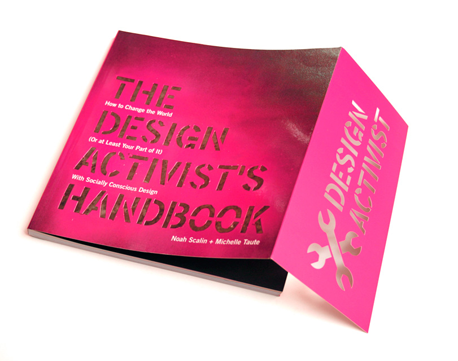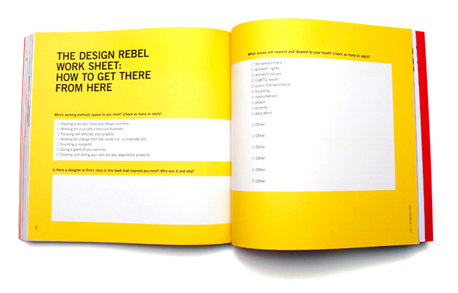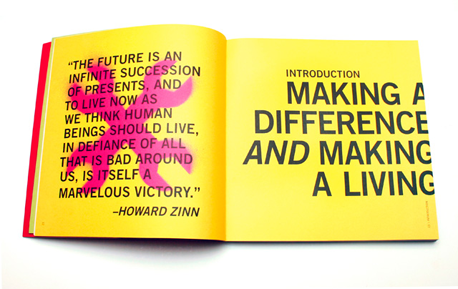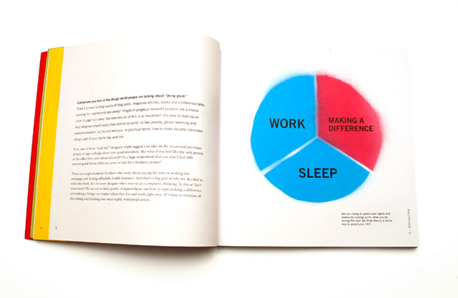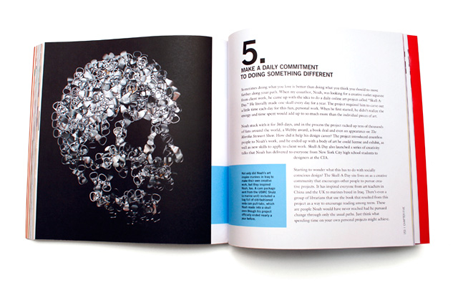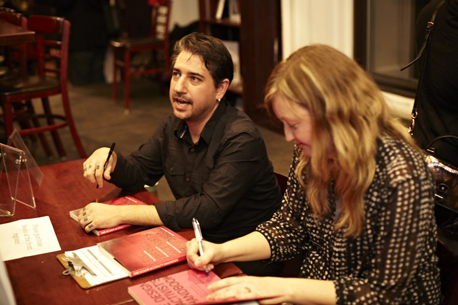An Interview with Noah Scalin and Michelle Taute on The Design Activist's Handbook
As part of a DROB series of interviews with authors, Jenny Venn interviews Noah Scalin and Michelle Taute about co-authoring the useful and inspiring book The Design Activists Handbook and about the emerging niche of designing for social change.
**Jenny Venn: ****Noah, you’ve worked with a variety of social change clients/projects over the years. What separates social change projects/clients from more traditional projects/clients you’ve worked for in the past? **
Noah Scalin: I think there’s a bit more pressure to do the best possible work you can. This isn’t just about selling a consumer product or service; if you do it right you could have a real impact on people’s lives and potentially the world. It helps that generally these types of clients are extremely passionate & knowledgeable about their work, so they are equally dedicated to making something that works.
**JV: ****The book is filled with very useful checklists and worksheets to guide us through starting the path towards a design for social change career. What would The Design Activist’s Handbook checklist be for working on a design for social change project? **
NS: The checklist for a socially conscious design project should basically be the same as any other design project, with really only one major addition, asking yourself “Does this client/project mesh with my personal ethics?” Of course that may mean doing some additional research, but once you have your answer you can proceed as you normally would.
**JV: ****What is your advice for a designer who aspires for a career designing for social change but is hesitant to take the leap from their current work situation? **
Michelle Taute: It’s not all or nothing. There’s no contest to be the most socially conscious designer. If you’re working somewhere that you don’t feel 100% good about, it probably means there’s a lot of room for change and improvement. Look for small ways to change things for the better at your current company. Then seek outside projects related to social change in the areas you’re most passionate about. Start small. Think big. If you begin right where you are, things have a way of snowballing.
**JV: ****What design for social change discoveries or unknowns did you encounter while creating the book? Did it inspire any additions to your own personal design process? **
MT: There’s a personal checklist for working with brands in the book that a designer submitted to us, and I found that really compelling. It made me re-evaluate my own client list and think about what really mattered to me when I partner with a company, agency or brand. I do a lot of design writing and copywriting.
**JV: Michelle, you mentioned to me previously that you are not a designer for social change but were intrigued by the movement and trend. Why is that? What did you find so inspiring? **
MT: I’ve been writing about design for more than a decade. In fact, I first talked with Noah for the first time when I wrote an article on socially conscious design for STEP magazine around 2004 or so. So it’s a topic I’m familiar with, but I felt like a lot of coverage just showed famous designers doing these big gorgeous projects. And those are great, but they all seemed to skip over the details. How do you get paid for this work? How do you land it? How can it work as a real part of your job if you don’t have the luxury of not worrying about money? Plus, I’d interviewed Noah a lot over the years, and I was really excited to collaborate with him.
**JV: **All clients seem to have limited funding for projects but non-profits and NGOs often believe that they have no advertising and marketing budget. How do you educate them on the importance of investing in marketing and advertising?
MT: First, don’t assume they don’t have a budget. Many non-profits and NGOs, especially larger ones, do have money to spend on marketing and design. In the book, we point out that the median salary for non-profit CEOs (and this was a stat for 2008) was $147,273. So, for starters, do a little research and find out what kind of means the organization has in the first place. I’ll let Noah fill you in on what he calls, “no-profits.”
NS: Design, when done right, is extremely valuable, and it really ends up being a part of a socially conscious designer’s job to educate the non-profit clients on that fact. Of course a non-profit’s number one priority should be their product or service, but number two should be letting people know it exists and that’s the designer’s job! Besides if we want to make a viable career out of doing good work then you need to get paid to do it, so pro-bono cannot be your go to option when it comes to these types of clients. That’s not to say that you can never do free work, but for me I restrict it to the clients that truly have no money and are generally entirely volunteer run, or as I say, they’re not non-profits, they’re no-profits!
**JV: ****What advice do you have for a student wanting to step into the design for social change arena straight out of college? **
NS: Don’t expect there to be a job waiting for you. While more and more people are interested in socially conscious design, there are still only a small number of firms/companies that are dedicated to it. So it may end up being about getting the best job you can and making it into the one you want.
That’s not to say that you shouldn’t try to get hired by a socially conscious firm, but I recommend trying to get an internship at one when you’re still in school, since there’s more of a chance of getting hired by them once you’ve graduated. And of course you can always build towards running your own socially conscious firm like I did by constantly doing freelance work, regardless of your day job.
**JV: ****If there was a Design Activist’s Handbook companion piece or field guide what would it include? **
NS: Happily there are already a few books out there that cover this. When it comes to the “why?” of socically conscious design I highly recommend people read _Do Good _Design by David Berman. If you want more detailed information on successful projects read Designing for Social Change by Andrew Shea. And if you need visual inspiration check out the excellent books Just Design by Christopher Simmons and Designing for The Greater Good by Peleg Top.
**JV: ****If there were one recent (within the last six months) design for social change project you could include in the Design Activist’s Handbook what would it be and why? **
NS: Wow, how do I pick? There are so many good projects constantly coming out. If you want to keep up with the best of them, I highly recommend following the site Osocio where I am a co-editor.
**JV: ****This book was a collaboration between a designer (Noah) and a writer (Michelle). What were the challenges and blessings of co-authoring? **
MT: We wrote this whole book via Skype! We’d talk every week about a different chapter while our cats ran across in front of the camera. Noah has black cats and I have a fluffy white cat, so it was dueling felines. It was really positive to have two different perspectives. Noah brought a great activist background to this, but I wanted to make sure we gave some ideas for in-house designers, too. How can you affect change from the inside? Having two folks also helped us reach out to a wider range of designers to contribute to the book.
**JV: ****What’s next for the field of design for social change? What do you think can we expect to see in next 5 years? **
NS: I think we are going to see an increase in the normalcy of people in all industries working from an ethical perspective, just as we’ve seen a rise in the normalcy of environmentalism in nearly every type of business. I think there will definitely be more socially conscious businesses developing out of the sheer fact that the old way of doing work is collapsing around us.
One of the few good aspects of the current poor job market here in the US is that it is harder for young designers to just fall into lucrative corporate careers right out of school; in a few more years we’ll be seeing the positive impact of so many of these young people using their passions to make opportunities for themselves.
The Design Activist’s Handbook is published by HOW Books and can be purchased from Amazon (US | UK).
About the Reviewer
Jenny Venn is a designer, educator, activist, and founder of StudioJenVenn, a for-cause design studio that is on sortie from jenvenn.com in Wichita, Kansas.
Photos: Noah Scalin and Jason Falchook


